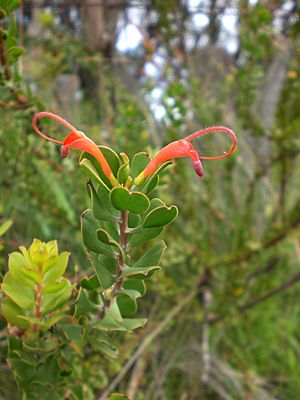Adenanthos sect. Eurylaema facts for kids
Quick facts for kids Adenanthos sect. Eurylaema |
|
|---|---|
 |
|
| Adenanthos obovatus, the type species of A. sect. Eurylaema | |
| Scientific classification |
|
| Kingdom: | Plantae |
| Clade: | Tracheophytes |
| Clade: | Angiosperms |
| Clade: | Eudicots |
| Order: | Proteales |
| Family: | Proteaceae |
| Genus: | Adenanthos |
| Section: | Adenanthos sect. Eurylaema Benth. |
| Species | |
Adenanthos sect. Eurylaema is a special group of flowering plants. These plants belong to the larger Adenanthos family, which is part of the Proteaceae plant group. There are four different types, or species, in this group. All of them grow only in the southwest part of Western Australia.
Contents
What Makes Them Special?
These plants have unique flowers. One key feature is that a part of the flower called the stamen (which usually makes pollen) is not able to produce seeds. Also, the end of the style (another part of the flower) is wide and flat.
How They Were Discovered and Named
Early Discoveries
This group of plants was first described by a scientist named George Bentham in 1870. He wrote about them in his important book, Flora Australiensis. Bentham noticed several things that made these plants stand out. For example, their flowers had a bent and wide tube, one of their four anthers (pollen-making parts) was sterile, and the tip of the style was broad and flat. He also noted their flat leaves and flowers that grew from the leaf axils.
The Name Eurylaema
Bentham didn't explain why he chose the name Eurylaema. However, another scientist, Ernest Charles Nelson, later figured it out. The name comes from two Greek words: eurys, meaning "broad," and laemos, meaning "neck." This refers to the wide, tube-like part of the flower.
Type Species
Bentham also didn't pick a "type species" for this group. A type species is like a main example that helps define the group. Nelson later chose A. obovatus to be the main example for A. sect. Eurylaema.
Adding More Species
When Bentham first described this group in 1870, it only included two species: A. barbigera (now called A. barbiger) and A. obovata (now A. obovatus). Four years later, another scientist, Ferdinand von Mueller, found and described a new species called A. detmoldii. He added it to this group.
Modern Understanding
In 1978, Ernest Charles Nelson did a big study of all Adenanthos plants. He kept A. sect. Eurylaema as a group, but he simplified the features used to identify it. He mainly focused on the sterile anther and the shape of the style-end.
The next year, Nelson officially named a new plant called A. × pamela. This plant is a natural mix, or hybrid, of A. detmoldii and A. obovatus. Even though both parent plants were in this group, Nelson didn't put the hybrid in it at first. But in 1995, when he wrote about Adenanthos for the Flora of Australia book series, he did include the hybrid in A. sect. Eurylaema.
Here's how the A. sect. Eurylaema group fits into the larger Adenanthos family:
- Adenanthos (The main group of plants)
- A. sect. Eurylaema (This special group)
- A. sect. Adenanthos (Another group with many more species)
Where They Live
All four species in the A. sect. Eurylaema group are found only in the southwest part of Western Australia. This means they are "endemic" to that area, growing nowhere else in the world naturally.
See also
 In Spanish: Adenanthos sect. Eurylaema para niños
In Spanish: Adenanthos sect. Eurylaema para niños

